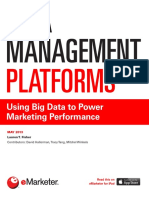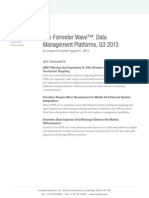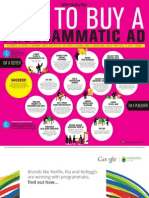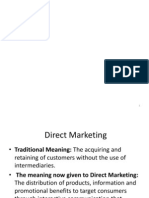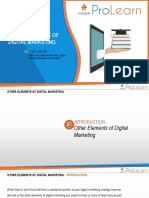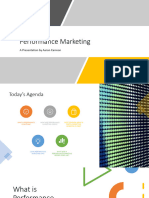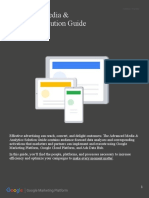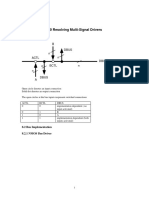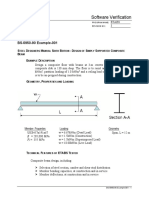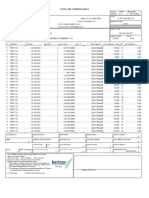Basic Introduction
Basic Information
What is DMP?
A data management platform (DMP) is a unifying platform to collect, organize and
activate first & third party data from any source, including online, offline,
mobile, and beyond. It is the backbone of data-driven marketing and allows
businesses to gain unique insights into their customers.
Check out this great marketing video to know more about DMP
While big data is instrumental to effective data-driven marketing campaigns, you
can’t do much with the raw information. You need it sorted and converted into a
usable form, at least so you can understand what you’re looking at. This is the
power of a DMP.
A DMP offers a central location for marketers to access and manage data like
mobile identifiers and cookie IDs to create targeting segments for their digital
advertising campaigns.
Publishers also often use DMPs to store data about their users. Then they can use
that information to create audience segments of their own to sell to advertisers.
Eskimi DMP collects and stores data which is received from 50+ exchanges that
Eskimi DSP is connected to. The big amount of exchanges enables Eskimi DMP to
collect over 2Bln of profiles .
What Does a DMP Do?
A DMP collects and organizes data from a variety first & third-party data sources
(ex. exchanges), and makes it available to other platforms such as DSPs to be used
for targeted advertising, personalization and beyond. Some people describe a data
management platform as the “pipes” of ad tech — connecting many platforms in a
neutral way so marketers can use their powerful audience data when and where they
want.
At Eskimi DMP enables various targeting opportunities - interest , remarketing
sites/apps and other targetings are influenced by data collection on DMP.
How Does a DMP Work?
A DMP can collect unstructured audience data from any source, including desktop,
mobile web, mobile app. A true DMP should collect audience data on more than a
surface level, going far beyond things like URL and keyword information.
This first-party data — that is the data you own and have collected directly from
your own customers — can be collected based on specific behaviors such as clicks,
downloads, video uploads or video completions, interests like sports, football,
parenting, museums and travel or demographic information. It can also include
demographic data, socio-economic data, influencer and action data. As an example, a
business can use a DMP to collect and organize data, then use that data to target a
particular ad to moms who are 25-35, there are endless applications of a DMP.
Eskimi's data management platform collects audience data from the following online
sources:
� Mobile web;
Mobile app;
Desktop sites;
User activity (click, impression, conversion audience);
Pixel audience (from clients website);
Why do marketers use DMPs?
With programmatic ad buying, advertisers are able to extend campaigns across a
huge number of sites and apps through ad exchanges, ad networks and demand side
platforms (DSPs). Data management platforms help marketers unify audience and
performance data across all of those sources.
A DMP enables advertisers to build audience segments — criteria can include
customer information, demographics, household income, past browsing behavior,
purchasing information, location, device and so on — and then it can analyze how
those segments performed. Based on that analysis, the campaigns can be continually
optimized to reach those audience segments that perform best.
Introduction to Programmatic
Meet Stanley, a middle-aged man in Nigeria. The first thing he does every morning -
he opens Punchng.com to see the latest political insights and sports news.
Thousands of advertisers want to show their ads to Stanley and programmatic ad
buying gives the possibility to efficiently do it. Even though Programmatic ad
buying has changed the face of online advertising, there’s still confusion around
what it actually is. Therefore, we wish to explore how the Programmatic ad buying
works from the lens of the usual online users.
Online Advertising With Programmatic Buying
The easiest explanation would be, programmatic is buying digital advertising space
automatically, with computers using data to decide which ads to buy and how much to
pay for them, often in real-time. There is, however, a frequent misunderstanding
that all programmatic is real-time advertising. That is a subset of programmatic.
Real-time advertising is an auction-based model, whereas programmatic is based
solely on automation. Programmatic can be split up into several features: Data
Management Platform (DMP). By enabling data and technology programmatic gives
marketers the possibility to have a lot of data points about users like Stanley,
from the device he is using to what interests him. Inventory. Also, one of the key
features of programmatic gave the possibility to move from one straightforward
media buy with a publisher to conducting media transactions on an impression-by-
impression basis. Rather than buying a million impressions on Punchng.com in one go
and committing to that over a period of time, a brand can buy a million impressions
and split them across multiple publishers or media owners, targeted at a particular
audience segment. Programmatic guaranty. Another aspect of programmatic
advertising is guaranteed impressions. A price is pre-agreed by the buyer and
seller before the impressions go live on the website. Real-time functionality.
Programmatic is enabling marketers to track the impact of their investment and
optimise their ad campaigns when reaching their relevant customers. The real-time
optimisation functionality gives brands the possibility to react to the market
fluctuation, user interactions online, and other relevant data points. To sum it,
with the machine learning capabilities Programmatic gives the opportunity to reach
users like Stanley and appear on sites such as Punchng.com. However, it is up to
the brand to decide if the programmatic adoption goes along with its niche business
goals.
�Introduction to Eskimi DSP
Eskimi DSP is a demand-side platform that allows advertisers to buy inventory
through ad exchanges in real-time. Using this platform, you can set up and launch
your campaign by yourself which will save time and costs. Moreover, this platform
helps to advertise and reach your wanted audience much easier by providing a
variety of relevant information such as what are your target audience is interested
in, what devices are they using, where do they use it, and so on.
Furthermore, Eskimi DSP is combined with a data management platform (DMP) where
the customer and online advertising data is stored and managed. For example, DMP
has a data dashboard that visually tracks, analyses, and displays your campaign
metrics in real-time. On the Eskimi DSP dashboard, you can see impressions, CPM,
Win rate, Clicks, CPC, CTR, best and worst-performing ads, Platforms, Operating
Systems, and Delivery Map by Hour.
Introduction to Successful Performance Campaigns
It is hard to deny that performance campaigns are difficult to carry out, but they
are the endpoint of all digital advertising. In the end, every client - no matter
what his/her area of business is – will want to get conversions. Since the
conversion flow is much more complicated than general brand awareness or traffic
campaigns, we would like to share a few key steps before heading towards
performance campaigns on Eskimi DSP. These guidelines should help you make your
campaigns more efficient as the key takeaways are solely based on our previous
campaign experiences:
Creative requirements
When analyzing previous performance campaigns, we have noticed that Native ads are
delivering 3 times higher conversion rate compared to display ads. Therefore, if
you want to have a successful conversion campaign, you should start with Native
ads. Additionally, we recommend having at least 2 communication lines for Native
ads. This way the user won’t be bombed with the same creative.
From display ads it is necessary to include creative dimensions - 300x250, 320x50,
320x100, 320x480, 300x600, 160x600, 728x90, 336x280. However, these suggestions do
not guarantee successful conversions and should be taken as recommendations.
Therefore we would still advise A/B test creative types, as for every business and
market different creatives tend to perform better.
Communication message
We have noticed that it is difficult to deliver a good CPA without clear
communication. In other words, the offering is very important. Ads have to clearly
inform a user why they should convert. Our tests showed that ads with a clear offer
showed 4 times higher conversion rate compared to ads without any offer.
We strongly advise having different language ads if you are working in
multilingual markets. In this case, you will reach a wider audience.
Also, it is necessary to add a clear Call-To-Action that will inform what the user
�has to do after clicking the ad. Register Now, Sign Up works well when generating
leads.
Additional Platforms
As we have mentioned performance campaigns are much more complex than other
objective campaigns. One source may not generate enough results. In this case, we
offer to add more than one channel for your conversion campaigns. As Eskimi DSP
offers the possibility to launch 2 major digital players – Google Ads and Facebook
- it becomes much easier to scale your performance. Enabling several channels will
let you optimize your campaigns with higher accuracy under one umbrella.
You can test direct leads form on Facebook and/or LinkedIn to increase your
conversion rate since both of these channels generate a 2-to-5 times higher
conversion rate depending on the complexity of the form compared to click-to-
website conversion.
You should keep in mind that each platform is unique and should be adapted to the
business. Meaning, that LinkedIn which is solely profession-based platform may not
work for food-based clients.
Technical Reuquirements
Eskimi DSP holds few technical requirements when working with conversion
campaigns. We require to have a unique landing page. This helps us to efficiently
track conversions on the dashboard. It is mandatory to implement tracking and
conversion pixels.
We have noticed that the most efficient campaigns were those who had a minimum of
5000$ budget and ran at least for a month.
If you are a new player in the market, we advise starting with brand awareness and
click-to-website campaigns. Then your digital advertising will generate a buzz in
the market and will give the users a chance to learn about your brand.
Other
No performance campaign is good if it is not monitored. Therefore, we advise to
track campaign performance on another 3rd party platform, such as Google Analytics,
and share performance stats with your Ad-ops team. This way Ad-ops will have a
better understanding of how the campaign is performing and will optimize it
accordingly.
If you are still trying to understand which audience converts the most - try to
segment the targeted audience so that you’d be able to see which audience pool is
driving the best results.
Also, a more advanced lead flow has to be discussed beforehand. Then we will be
able to give you the best solution for your planned goal.
To wrap it up - a lot of things come down to testing as each brand and market are
unique. Thus, we advise to not fall over fast conversion trends. As in most cases,
it would only bring a lousy performance that wouldn’t bring any benefit to your
�return on investment. If you have any inquiries or doubts feel free to contact us
for a discussion as we believe we can find a relevant digital solution for each
brand.

